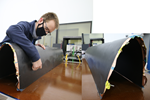Zentek develops carbon-based, nanotechnology-enhanced icephobic coating to reduce ice accretion
Preliminary results demonstrate an adhesion strength of 20 kPA, which is a 96% improvement over aluminum alloys. The coating will be tested under real, ice-forming weather conditions this winter.

Aircraft on deicing platform. Photo Credit: Getty Images
Zentek Ltd. (Ontario, Canada), an IP development and commercialization company focused on next-generation healthcare solutions, announces the development of a patent-pending, carbon-based, nanotechnology-enhanced coating designed to prevent ice accretion. The company anticipates applications for aircraft, wind turbines, ocean vessels and building structures to increase safety and efficiency outcomes in ice-forming weather conditions.
During the testing process with a third party lab, various coatings were tested for adhesion strength as measured by pressure in kilopascals (kPa) required to dislodge ice from an object’s surface. Zentek says its coating demonstrated an adhesion strength consistently around 20 kPa, which is considered to be a significant improvement over the current commercial products. For comparison, the ice adhesion strength of a bare aluminum alloy is ~500 kPa; to be classified as icephobic, adhesive strength must be less than 100 kPa.
The company’s preliminary results reportedly demonstrated a 96% improvement over aluminum and 80% improvement over the 100 kPa threshold. As a result, Zentek’s coating will be included in flight testing on a specially equipped research aircraft this winter under real, ice-forming weather conditions by the third party. Zentek will also test the feasibility of this coating as an effective passive means to de-ice drone propellors in flight to permit all-weather operations. If successful, this would permit safer drone operations in substantially more challenging weather conditions.
“We continue to actively develop new nanotechnology-enabled applications in high-impact areas, which, in this case, has the potential to significantly increase safety for vehicles such as drones, aircraft, ocean vessels, wind turbines and other applications where, in cold weather climates, there is the potential for ice to accrete on surfaces, causing hazardous breakdowns in function,” comments Greg Fenton, Zentek CEO. “Our mission continues to be to develop innovative nanotechnologies that improve people’s lives — and while our focus is primarily on nanotechnology-enabled healthcare solutions — we are also making breakthroughs that substantially contribute in other industries that may result in vital steps forward to ensure public safety and enhance sustainability.”
Previous research has shown that while certain coatings may demonstrate the prevention of ice adhesion, they have been limited to a laboratory environment and questions remain concerning the durability necessary for them to be considered a practical application as an aircraft ice protection system (IPS). The development of a nanotechnology-enhanced coating with dispersed graphene may have the potential to address this through the enhancement of the bulk mechanical properties. On Aug. 9, 2021, Zentek filed a provisional patent on this technology with the U.S. Patent and Trademark Office.
The company has begun to explore partnership opportunities and will communicate progress as appropriate.
















